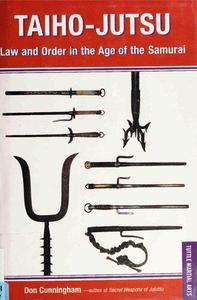 Taiho-Jutsu: Law and Order in the Age of the Samurai By Don Cunningham
Taiho-Jutsu: Law and Order in the Age of the Samurai By Don Cunningham2004 | 192 Pages | ISBN: 0804835365 | PDF | 47 MB
In Taiho-Jutsu: Law and Order in the Age of the Samurai, author and judo second-dan Don Cunningham provides a fascinating introduction to the civil society of Edo-period (1603-1867) Japan-particularly the role played by the well-known warrior class, the samurai.During the enforced peace of this era, many of the samurai were unemployed and had great difficulty earning a living. Some were even forced to join the lower classes-of merchants and chonin (commoners)-to get by. These circumstances redefined the part the samurai played in Japanese society, and challenged the traditional caste system.Cunningham shows that the samurai were not, as commonly portrayed, always all-powerful mediators ruling the chonin through the power of their swords. During this period the samurai became a part of the complex system of Japanese law enforcement. Made up of samurai as well as machi-bugyo-sho (town magistrates), yoriki ("assistant" samurai), doshin (samurai patrol officers), komono (assistants), goyokiki (part-time police assistants) and okappiki (informants and spies)-this intricate structure mirrored the Japanese society of the day.Taiho-Jutsu offers a detailed look at the weapons these law enforcement officers used-including the jutte (iron truncheon), tesson (iron fan), yori-bo (wooden staff), sodegarami (sleeve entangler), sasumata (spear fork), and torinawa (arresting ropes)-as well as a fascinating illustrated look at the techniques used to apprehend criminals. From kamae (stances) to parrying and striking and throwing techniques, these explanations demonstrate the practical techniques in Edo-period Japan.



![S.T.A.L.K.E.R. 2 / STALKER 2: Heart of Chornobyl - Ultimate Edition (2024) [+UPDATE 23.12.2024 - v1.1.3] ElAmigos / Polska wersja językowa](https://i.postimg.cc/Zqd8RWGY/UZG8PBE.jpg)



















































![David Gilmour - Luck and Strange (2024) [FLAC]](https://i.imgur.com/everaBc.jpeg)
![Męskie Granie Orkiestra - Męskie Granie 2024 (2024) [FLAC]](https://i.imgur.com/FAyOxrM.jpeg)
![The Rolling Stones - Hackney Diamonds (2023) [FLAC]](https://i.imgur.com/wCkyyUN.jpg)
![Lady Gaga - Harlequin (2024) [FLAC]](https://i.imgur.com/dcgIA8D.jpeg)
![Natalia Kukulska - Dobrostan (2024) [FLAC]](https://i.imgur.com/bdljG3O.jpeg)
![Kaśka Sochacka - Ta druga (2024) [FLAC]](https://i.imgur.com/hORQKvn.jpeg)
![Kuba Sienkiewicz - Pani Bóg (2024) [FLAC]](https://i.imgur.com/qijCx8Z.jpeg)
![Lanberry - Heca (2024) [FLAC]](https://i.imgur.com/8P7QfeR.jpeg)
![Sara James - PLAYHOUSE (2024) [FLAC]](https://i.imgur.com/m4f8OKg.jpeg)
![Grzegorz Hyży - EPILOG (2024) [FLAC]](https://i.imgur.com/8DA2sBr.jpeg)
![Myslovitz - WIECZORAMI CHŁOPCY WYCHODZĄ NA ULICE (2024) [FLAC]](https://i.imgur.com/l9mMtIG.jpeg)
![Krzysztof Zalewski - ZGŁOWY (2024) [FLAC]](https://i.imgur.com/vh48RAc.jpeg)
![Krzysztof Cugowski - Wiek to tylko liczba (2024) [FLAC]](https://i.imgur.com/SBzgqe2.jpeg)
![Nosowska - Kasia i Błażej (2024) [FLAC]](https://i.imgur.com/mObvVXQ.jpeg)
![sanah - Pianinkowe Kaprysy (2024) [FLAC]](https://i.imgur.com/pVjjPAa.jpeg)
![Kwiat Jabłoni - Pokaz slajdów (2023) [FLAC]](https://i.imgur.com/diERHfZ.jpg)
![Robert Cichy - Spacer po Warszawie (2024) [FLAC]](https://i.imgur.com/ixleU9o.jpeg)
![Viki Gabor - Terminal 3 (2024) [FLAC]](https://i.imgur.com/Q1KCnDs.jpeg)
![Sanah - Kaprysy (2024) [FLAC]](https://i.imgur.com/71OZm4h.jpeg)
![Męskie Granie Orkiestra - Męskie Granie 2023 (2023) [FLAC]](https://i.imgur.com/U4YHo8d.jpg)




